- Expert advice/
- Invites & paper/
- Day-of paper/
- A Guide to Wedding Ceremony Programs
- Day-of paper
A Guide to Wedding Ceremony Programs
Wedding ceremony programs communicate valuable information to your guests about your ceremony service—find out all you need to know to choose, word, and personalize your wedding programs.
Last updated February 5, 2024
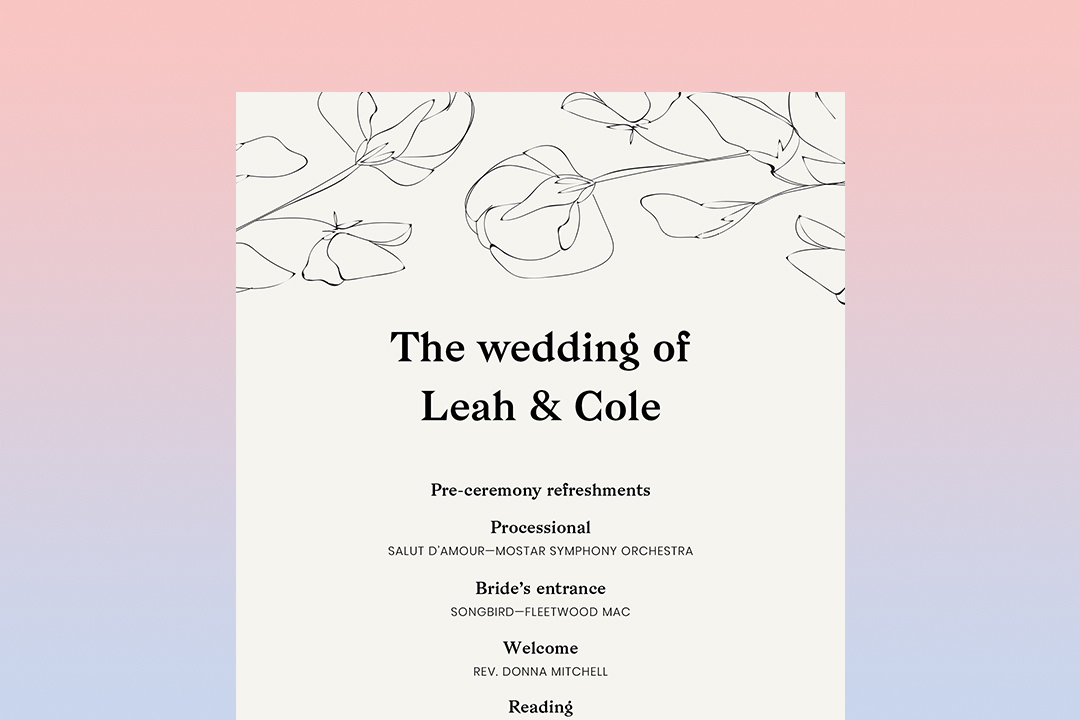
The First Look ✨
- Wedding ceremony programs lay out the schedule for the day’s festivities and set an overall tone.
- Not everyone needs a wedding program, but they’re a great way to welcome guests, reinforce your theme, and express gratitude.
- You should aim to include the couple’s names, the date and venue, the order of events, requests you may have of your guests, and a welcome or thank you message.
In the realm of wedding stationery, day-of paper such as menus and ceremony programs don’t always get as much immediate attention in the early stages of wedding planning. However, these elements are just as crucial to your wedding guests as those wedding invitations. Here’s everything you need to know about traditional wedding programs, whether you need a traditional wedding program or a non-traditional wedding program. Keep scrolling for wedding program templates and wedding program wording examples.
What Is a Wedding Ceremony Program?
While you’re busy crossing off item after item on your Wedding Checklist, don’t let programs pass you by. While they may not seem important, wedding programs play a vital role in communicating information to your guests and setting the tone for the most significant part of the day—the ceremony itself. Give some thought early on to your programs so that you can create a totally coordinating paper suite (including save the dates, invitations, programs, and other wedding paper) such as the ones available on Zola.
Programs are pretty standard items at most weddings these days, but if you’ve never been to a wedding or are unfamiliar with them, you might be asking yourself: what even is a wedding ceremony program? A wedding ceremony program serves two purposes:
-
Like any other program you receive during a live performance, it shares the order of events, the key players (parents, bridesmaids, wedding party, etc.), and gives details about the ceremony service that guests are about to witness.
-
It offers a place for the couple to share messages directly with their gathered friends and family, including giving thanks, recognizing important people, expressing their intentions, and communicating important event details.
Do You Need a Wedding Ceremony Program?
Sure, you could get away without a wedding program—your ceremony would probably still go off without a hitch, and afterward, you’d still be married. But programs are easy to create, helpful for everyone, and add an extra dose of fun, beauty, personality, and charm to your wedding day. Here are some reasons you should consider having a wedding ceremony program:
-
Programs officially welcome guests to the wedding itself. They might contain the first direct words from you to those who have made the effort to witness this moment, so they are a valuable piece of messaging real estate.
-
Beyond setting the tone through words, programs can introduce your wedding style and/or reinforce your wedding theme. They come in all kinds of different shapes, colors, and designs, so they are a great opportunity to set the mood and hint at the type of celebration to come.
-
Programs are a handy place to list the information guests need in order to prepare for hours to come: the ceremony timeline, what follows it, what kinds of transportation will be available at various times, and any other special requests you’re asking of them (sign our guest book/bench/guitar, please put away your phones, etc.).
-
Programs help your guests better understand, and enjoy, your ceremony. If your ceremony is very long, if you are are incorporating a lot of readings, songs, or other personal elements, or if you are having a traditional wedding ceremony and many guests are from a different religion or culture, then the information you include in your program will help guide them through the service and make it more meaningful.
-
Your program allows you to express gratitude, honor lost loved ones, and mention your main supporters in a visible, permanent way. People will be reading your program at the beginning of the ceremony, when they are fresh and you have their captive attention. Even if you plan to give a speech later, your audience will not be 100% present or focused (hello, open bar). Take the opportunity to record your feelings and share your heartfelt thanks in this saveable, scrapbook-able piece of paper.
What to Include on Your Wedding Ceremony Program
Exactly what you include in your ceremony program is entirely up to you, but here are some suggestions to keep in mind, from the obvious to the optional.
-
Your names, the wedding date, and wedding location.
-
The order of events of the ceremony. Include the names of songs used at different portions of the service, as well as the names, authors, and sources of readings, poems, and prayers. Here’s a general run-down of what your ceremony outline could contain (but of course, yours could look different based on the religious or cultural traditions you’re incorporating):
- Seating of the Grandparents
- Seating of the Mothers
- Processional
- Bridal Processional
- Welcome
- Prayer
- Message
- Reading(s)
- Exchange of Vows
- Exchange of Rings
- Pronouncement of Marriage
- Presentation of the Couple
- Recessional
-
If you have the room, some couples choose to share the lyrics of their specially chosen songs or the entirety of their readings or vows in the program for guests to follow along.
-
The names of the important players in your ceremony. This includes members of your wedding party, family members, your officiant, readers, musicians, or anyone else who plays a role in the service.
-
A brief explanation of any cultural, religious, or other rituals you’ve included in your ceremony. Explaining the significance and meaning behind what your guests are watching will help make the experience richer and more engaging for them.
-
A welcome message to your guests thanking them for making the trip and being present at your nuptials.
-
Any logistical messages or requests you want to share with your guests, such as:
- What happens after the ceremony (cocktails, a shuttle to the reception, etc.)
- The times and locations for early and late departure shuttles
- Instructions for what to toss, wave, or do when you process back down the aisle
- Requests for an “unplugged” ceremony (i.e., turn off your phones)
- Requests to not take photos and/or post anything on social media
-
A special note of thanks to your families, important vendors, or anyone else who helped make this day happen.
-
Words of love and remembrance for loved ones who could not be present for the occasion or who have passed away.
-
Your wedding hashtag, if you want guests to post all of their photos and wedding day memories in a way that you (and everyone else) can easily find online.
Tips for Your Wedding Ceremony Programs
1. Coordinate them with your invitations
For a truly custom feel, choose a coordinating design for your entire wedding paper suite. You can shop for matching save the dates, invitations, enclosure cards, programs, menu cards, and thank you cards on Zola, all of which also come with a coordinating (and free) wedding website. Since they come in tons of different, equally stunning designs, you can find one that easily fits your wedding theme or style.
2. Reinforce your wedding theme
Along the lines of theme, wedding ceremony programs are a great way to establish the style and mood of your big day. Whether you kick off your outdoor garden party with floral accents or set the tone for your preppy, nautical wedding with navy and white stripes, matching your program to your wedding’s decorative theme will put your guess in the right frame of mind.
3. Keep it simple and brief
Now you have a lot of ideas for what to write in your programs, but you don’t have to—and probably shouldn’t—include all of it. Remember that the ceremony program is meant to be a guide to the bigger show (i.e., your marriage service), so give guests just enough information to make them feel included in without overwhelming or distracting them with too much text.
4. Consider how many you really need
Depending on your budget, you might not choose to print one program for every attending guest. This is one area where you can cut costs by only printing one program for every couple, or two per family if there will be many families with children in attendance.
Wedding Ceremony Program Examples
Take the guesswork out of your wedding program wording and templates with this quick collection of wedding program examples.
Sample Program Language: Non-Religious Service
The wedding of
Name and Name
Date
City, State
Pre-Ceremony Refreshments
Processional
Song Name—Composer/Artist
Bride’s Entrance
Song Name—Composer/Artist
Welcome
Officiant’s Name
Reading
Title, Author
Exchange of Vows and Rings
First Kiss
Recessional
Song Name—Composer/Artist
Confetti is under your seat for the recessional!
Sample Program Language: Episcopalian Service
The Celebration and Blessing of the Marriage of
Name and Name
Date
Time
Name of Church
City, State
Prelude
Seating of the Family
Song Name—Composer/Artist
Processional
Song Name—Composer/Artist
Entrance of the Bride
Song Name—Composer/Artist
Invitation Book of Common Prayer, page #
Declaration of Consent
Collect for Marriage, page #
Scripture Reading
Book of the Bible Chapter: Verse #
The Homily
The Marriage, page #
The Signing of the Register
Song Name—Composer
The Prayers, page #
The Blessing of Marriage, page #
Recessional
Song Name—Composer/Artist
Postlude
Sample Program Language: Catholic Service
A Celebration of Marriage
Bride's Name
and
Groom's Name
Date
Name of Church or Chapel
City, State
Prelude
Song Name—Composer/Artist
Processional
Song Name—Composer/Artist
Bride's Processional
Song Name—Composer/Artist
Liturgy of the Word
Opening Prayer
First Reading—Book of the Bible Chapter: Verse, Name of Reader
Responsorial Psalm: Name of Psalm, Name of Reader
Second Reading—Book of the Bible Chapter: Verse, Name of Reader
Gospel Acclamation—Book of the Bible Chapter: Verse, Name of Reader
Homily
Sacrament of Marriage
Exchange of Vows
Blessing and Exchange of Rings
Prayer of the Faithful
Name of Reader
Response: Lord Hear Our Prayer
Presentation of the Gifts
Liturgy of the Eucharist
Eucharistic Prayer
Lord's Prayer
Nuptial Blessing
Sign of Peace
Communion
Song Name—Composer/Artist
Name of Singer
Presentation of Flowers to the Blessed Mother
Song Name—Composer/Artist
Final Blessing
Recessional
Song Name—Composer/Artist
Sample Program Language: Jewish Service
The Wedding Ceremony Uniting
Name
and
Name
Venue
City, State
Date
Prelude
Seating of the Guests
Processional
Entrance of the Rabbi
Entrance of the Best Man
Entrance of the Groom
Song Name—Composer/Artist
Entrance of the Maid of Honor and Bridesmaids
Song Name—Composer/Artist
Entrance of the Bride
Song Name—Composer/Artist
Ceremony
Opening Blessings
Blessing Over the Wine (Birkat Erusin)
Message From the Rabbi
Exchange of Vows and Ring Exchange
Seven Blessings (Sheva Brachot)
Breaking of the Glass
Recessional
Song Name—Composer/Artist
Jewish Wedding Traditions and Their Meanings
-
Chuppah: The Chuppah, or marriage canopy, represents the home that NAME and NAME will build together. The Chuppah has no walls to represent that marriage begins with just a roof. NAME and NAME will build the walls with love and friendship, based on a foundation of love and respect. The Chuppah is open on all four sides, symbolizing a home that is open to family and friends.
-
Ketubah: The Ketubah is a marriage contract, required by Jewish law, attesting to the commitments and obligations NAME and NAME make to each other as a married couple. It is one of the oldest elements of Jewish weddings, dating back over two thousand years. Prior to the ceremony, the Ketubah was signed by NAME and NAME.
-
Birkat Erusin: The rabbi will recite the Birkat Erusin, the engagement blessing, over a cup of wine. The cup is filled to overflowing, as we hope that the lives of the bride and groom will overflow with blessings. NAME and NAME will share a cup of wine, a Jewish symbol of happiness and the sanctification of a joyous time.
-
Exchanging of the Rings: According to Jewish law, the rings must be solid metal, devoid of any cuts or stones. As the rings are circles with no beginning and no end they symbolize that NAME and NAME’s love is never-ending.
-
The Seven Blessings: The Sheva Brachot, or seven traditional blessings, is the most ancient of the Jewish wedding traditions and the heart of the ceremony. These seven blessings symbolize the seven days of creation. The blessings represent the joy of creation both in the ancient times and the newest creation which occurs under the Chuppah. A second glass of wine is shared at this time.
-
*The Breaking of the Glass:* At the conclusion of the ceremony, NAME will break a glass by stepping on it. Traditionally this custom is a reminder of the destruction of the first temple and the may losses that have been suffered by the Jewish people. It is also a reminder that relationships are as fragile as glass, and must always be treated with care and love. A more contemporary interpretation is that the sound of the breaking glass travels through time and space to share the couples’ joy with all who have loved them, including those separated by time and distance. The sound of the glass breaking is greeted with shouts of “mazel tov”—a wish for good fortune to the newly married couple.
Types of Paper Wedding Programs
-
Flat Card: the most standard type of paper program, a flat card is the easiest and most affordable to design, purchase, and print. It allows you to fill the space on the front and back of the card with your information.
-
Paddle Fan: if you’re getting married outside during warm months, a paddle fan program is a popular choice. Essentially just a flat card attached to a wooden stick, a paddle fan program gives guests a way to cool off while they read more about your ceremony.
-
Multi-panel Fan: in this program style, several sheets of paper are attached with a metal grommet or ring, allowing the pages to be spread open like a fan. The shape and size of the sheets can vary to your liking, from rounded to teardrop to long and vertical.
-
Tri-fold: a larger sheet of paper is folded three times vertically, making for a ceremony program with a self-opening cover that reveals three separate panels.
-
Accordion: similar to tri-fold, an accordion program design involves folding a large sheet of paper back and forth on itself several times to create multiple, attached panels.
-
Booklet: like it sounds, a booklet program design binds together several pages of paper (of any size or shape) so that they open like a little book. Ribbon, raffia, or other material can be used to tie together the pages, or a booklet program can be stapled in the center and folded by a professional printer.
Creative Ideas for Wedding Ceremony Programs
-
Favor bags: Print your program details on small paper bags, then fill those bags with favors for a two-in-one handout. Favor ideas include edible treats like popcorn, donuts, or cookies, or useful keepsakes like sunglasses.
-
Include toss or send-off tools: Similar to favor bags, print your programs on paper bags filled with toss petals or confetti so that guests are primed for your ceremony exit. Or, turn the programs themselves into fans with streaming ribbons for guests to wave.
-
Giant chalkboard or mirrored sign: Instead of creating individual programs per guest, write your ceremony details on a large surface—think chalkboard, mirror, or even etched into acrylic—and present it in a visible, beautiful way for guests to read as they enter the ceremony.
-
Use engagement photos: Put those beautiful engagement portraits to good use by including a photo of you two on your ceremony program.
-
Include tissues: If you expect a lot of happy tears to be shed during your ceremony, add a cute touch to your program by using washi tape to attach a single, folded tissue to the back.
-
Design them like a newspaper or a playbill: This idea is especially appropriate if you or your partner like writing, journalism, or the performing arts. A fun format like the front page of a newspaper or the playbill to a Broadway show allows you to share both your information and your creativity.
-
Infographic or flow chart: There’s no rule that says your program has to be all words. If you or your partner are into graphic design, tell your wedding story through symbols, charts, and other inventive visual narratives.
Up next for you
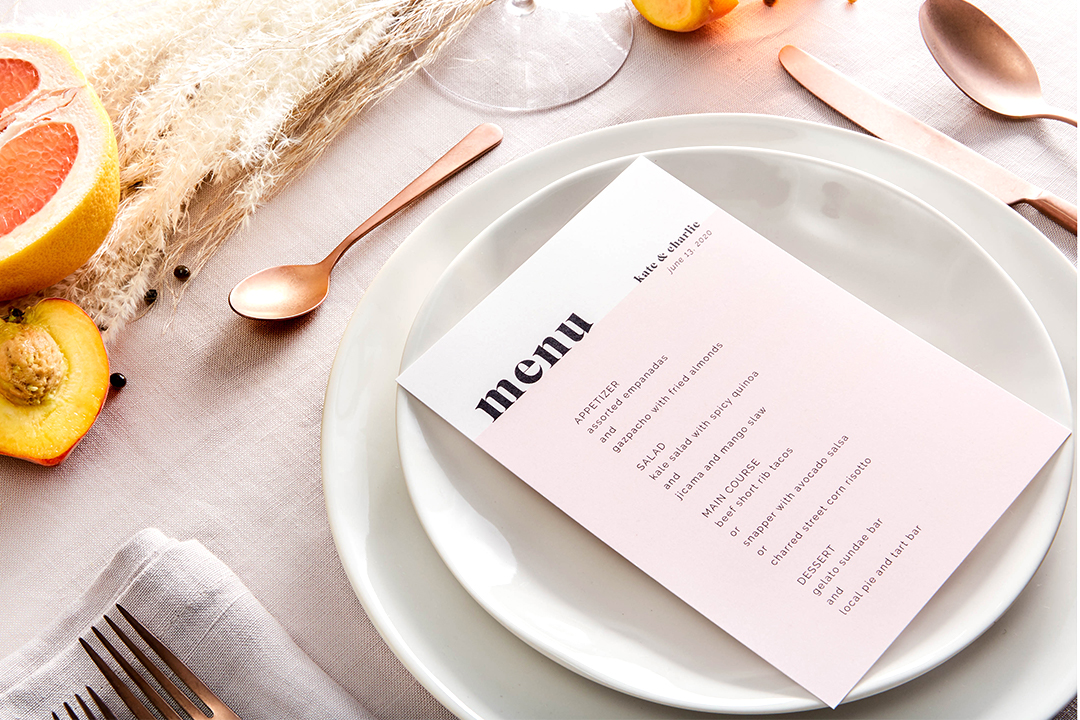
A Guide to Wedding Menu Cards
Inspiration
Discover everything there is to know about wedding menu cards in our guide.
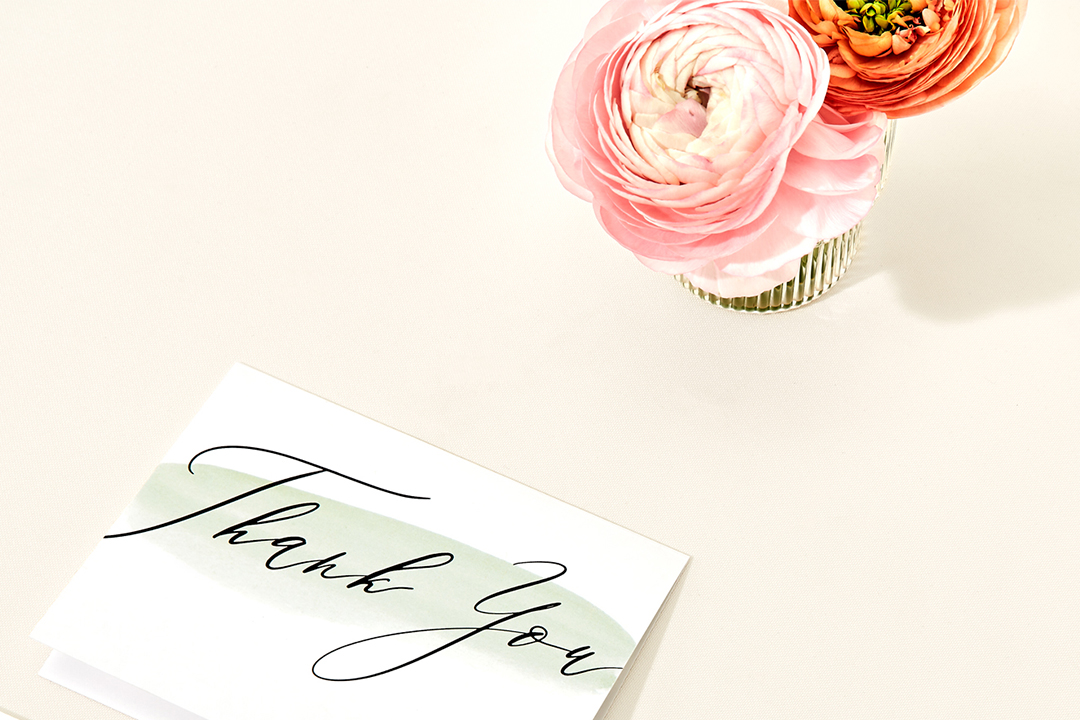
How to Write Wedding Thank You Cards
How-To
Here are some etiquette tips and timing guidelines to help you mail your wedding thank you notes in proper style.
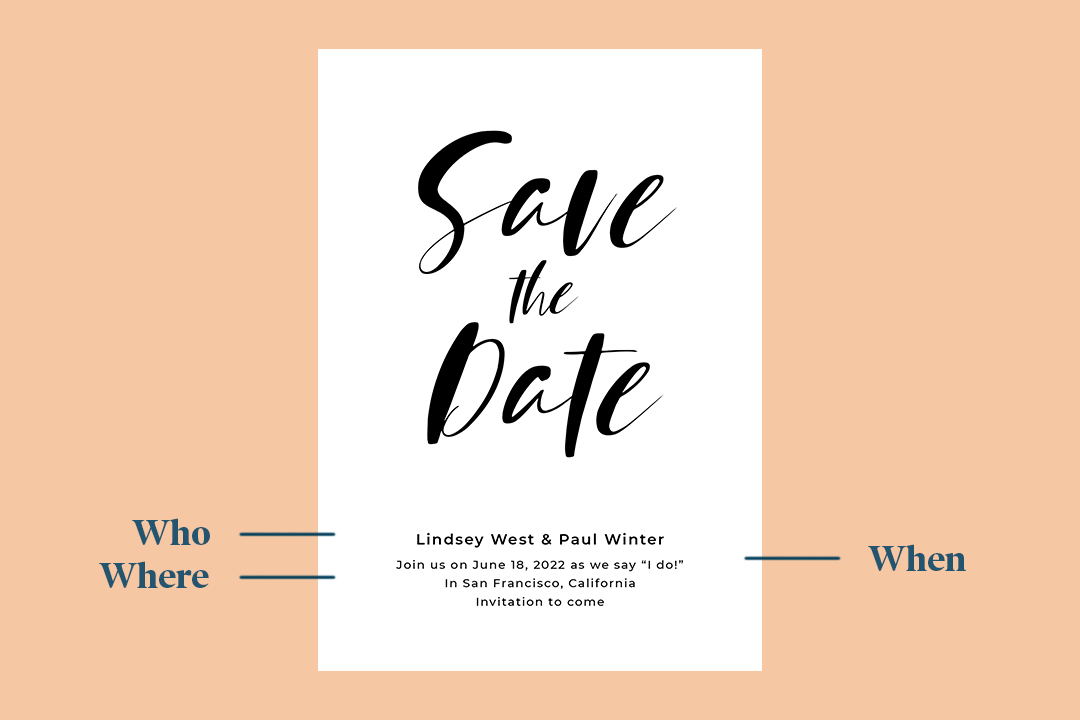
A Guide to Save The Dates
Inspiration
Save the dates add an extra touch of style and coordination to your wedding. Find out why and when you should send your save the dates with this complete guide.
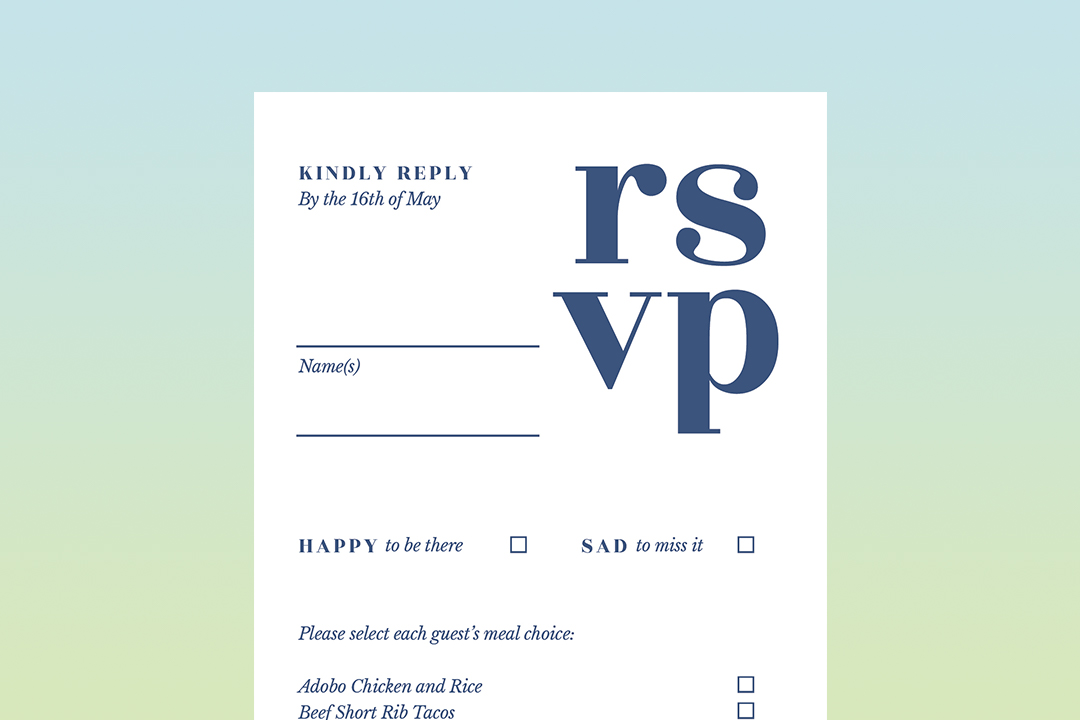
An Expert Guide to Wedding RSVP Cards & Complete Stationery Packages
Inspiration
Master wedding RSVP etiquette and discover complete wedding stationery packages with perfectly coordinated RSVP cards, free addressing, quality paper, and matching designs.

What to Include on Your Wedding Website + How to Write It
How-To
Your wedding website is a key place to communicate with your guests and share pertinent information, so it’s important to write well to avoid confusion. Keep reading for writing tips, wording samples, and a breakdown of what to include in each section of your wedding website.
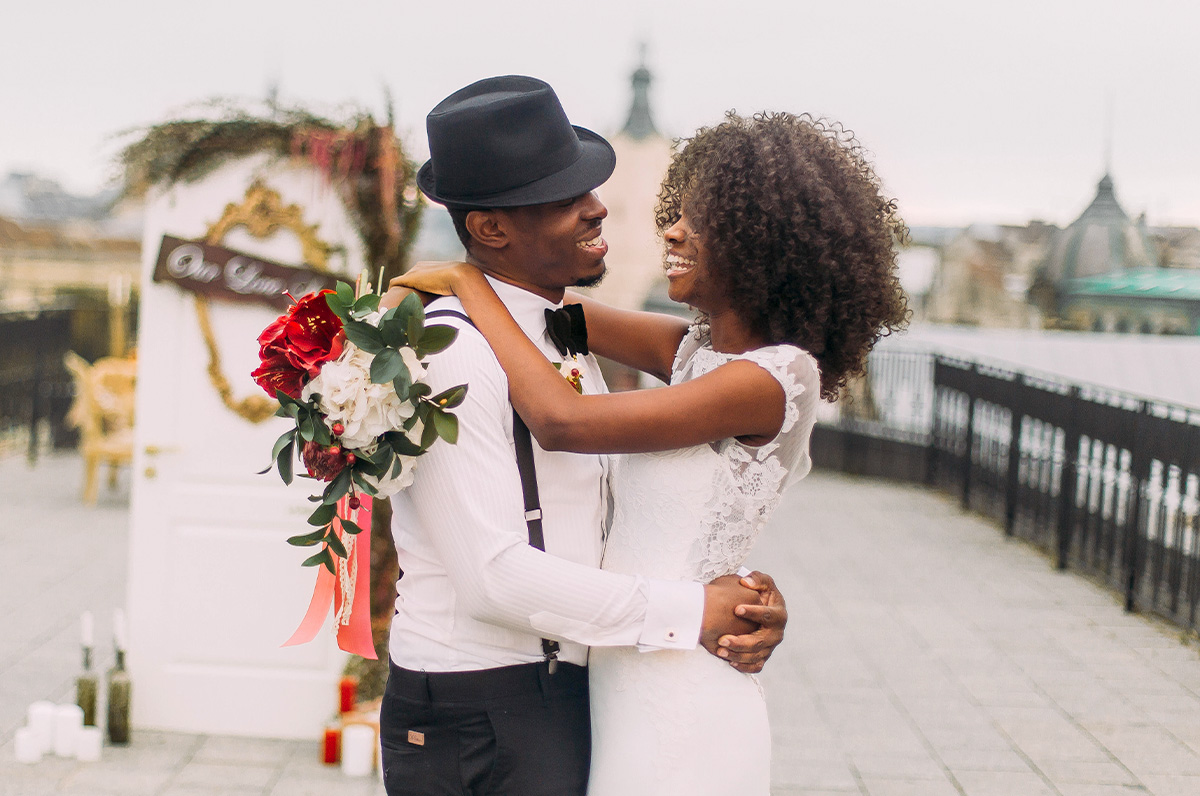
A Guide to Wedding Vows
Inspiration
Learn all you need to know about wedding vows and use our flowchart to determine whether you should write your own—plus find tons of examples of traditional vows to inspire you.
Featured
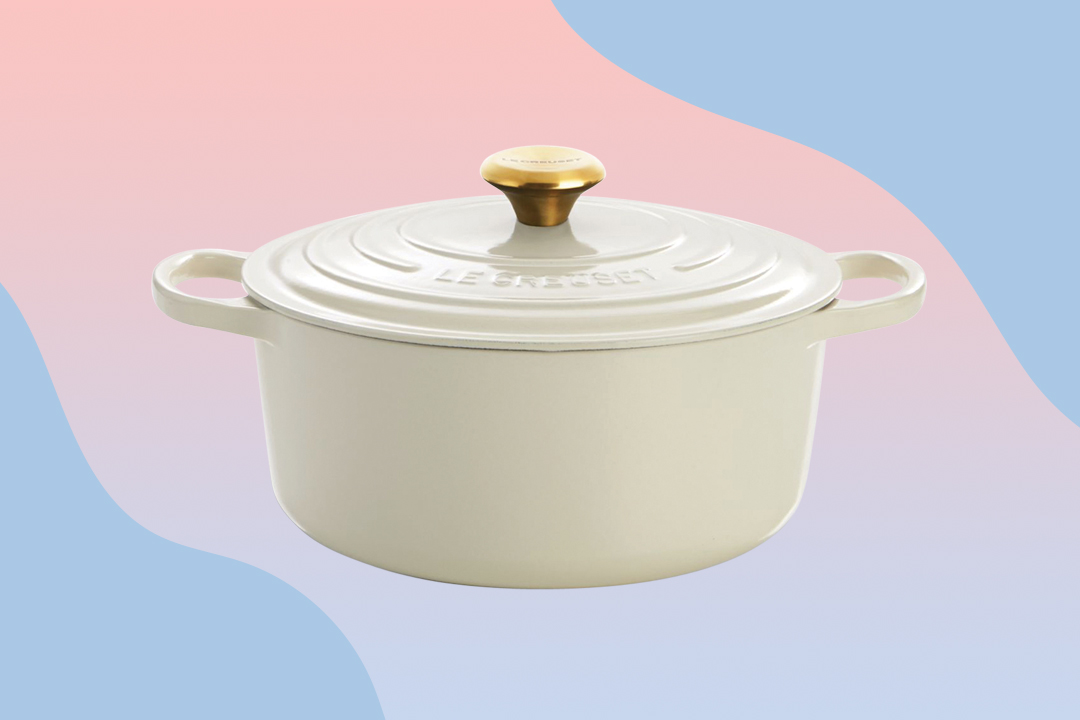
Essentials to Put on Your Wedding Registry
Inspiration
Get started building your registry with our a super-comprehensive checklist of list registry essentials, straight from our team of experts, that will cover ALL of your needs and help you build the newlywed home of your dreams.
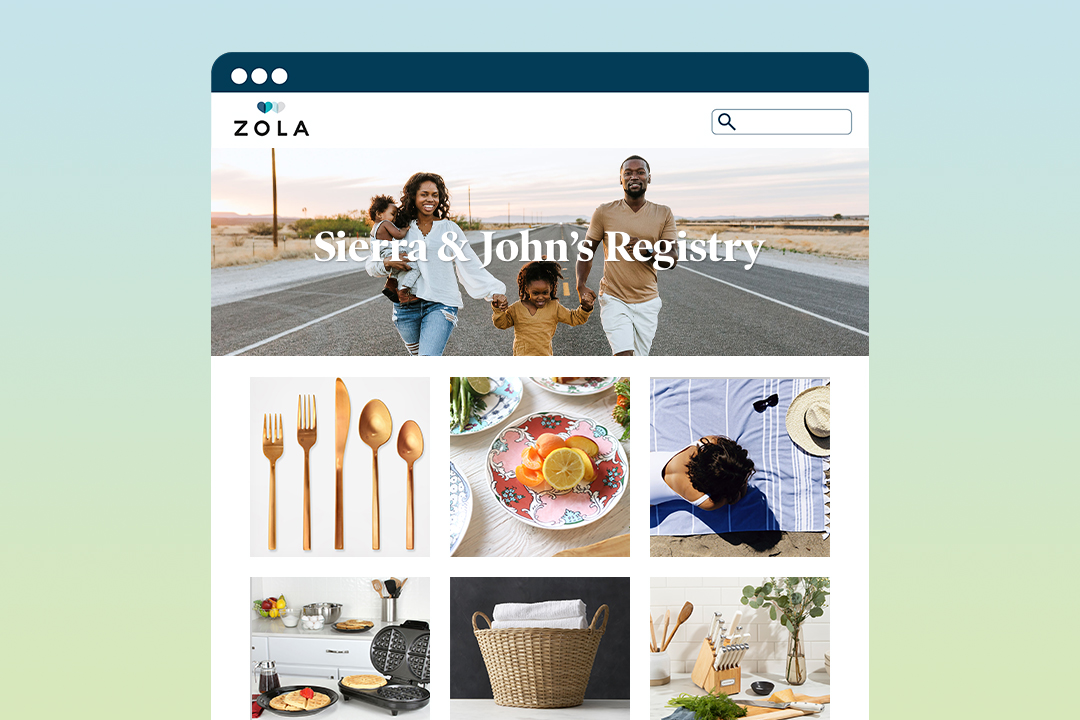
How to Create a Registry if You Already Live Together
How-To
We're here to tell you why building a wedding registry is still really necessary, regardless of whether you live together before marriage.
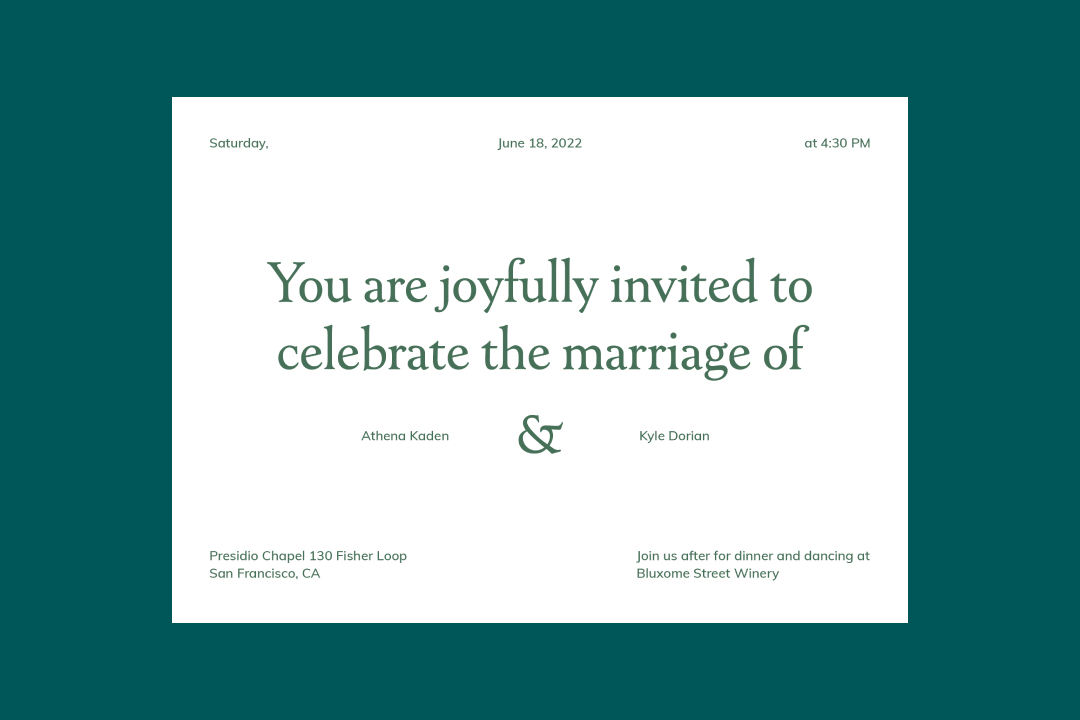
Wedding Invitation Wording: A Complete How-To Guide
How-To
Learn the how-to's of wedding invitation wording, plus formal and casual wedding invitation examples from the experts.

Average Cost of Weddings in 2025: Vendor Price Guide
Advice
Average cost of weddings in 2025: See national averages for venues at $8,573 and catering at $6,927, plus key vendor costs to plan your budget.
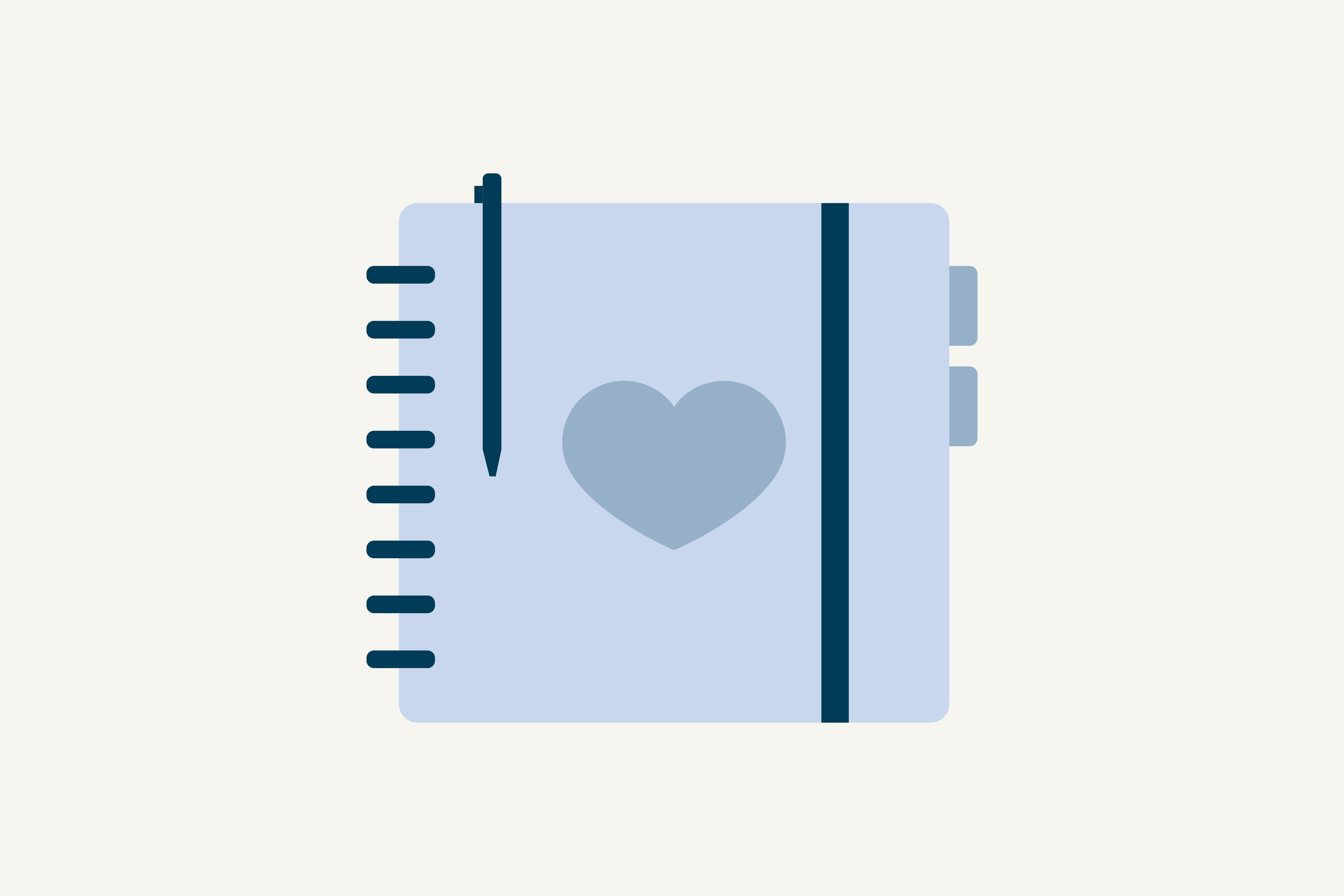
How to Plan a Wedding: A Step-by-Step Guide
How-To
We’ll walk you through the steps of online wedding planning, highlighting all of Zola’s incredibly easy and intuitive online wedding planning tools that’ll make planning for the big day more fun and less frustrating.

How to Plan a Wedding on a Budget
How-To
Thousands of couples have incredible weddings every year without sacrificing on style or going over budget, and you can do it too.
- Expert advice/
- Invites & paper/
- Day-of paper/
- A Guide to Wedding Ceremony Programs
Find even more wedding ideas, inspo, tips, and tricks
We’ve got wedding planning advice on everything from save the dates to wedding cakes.
